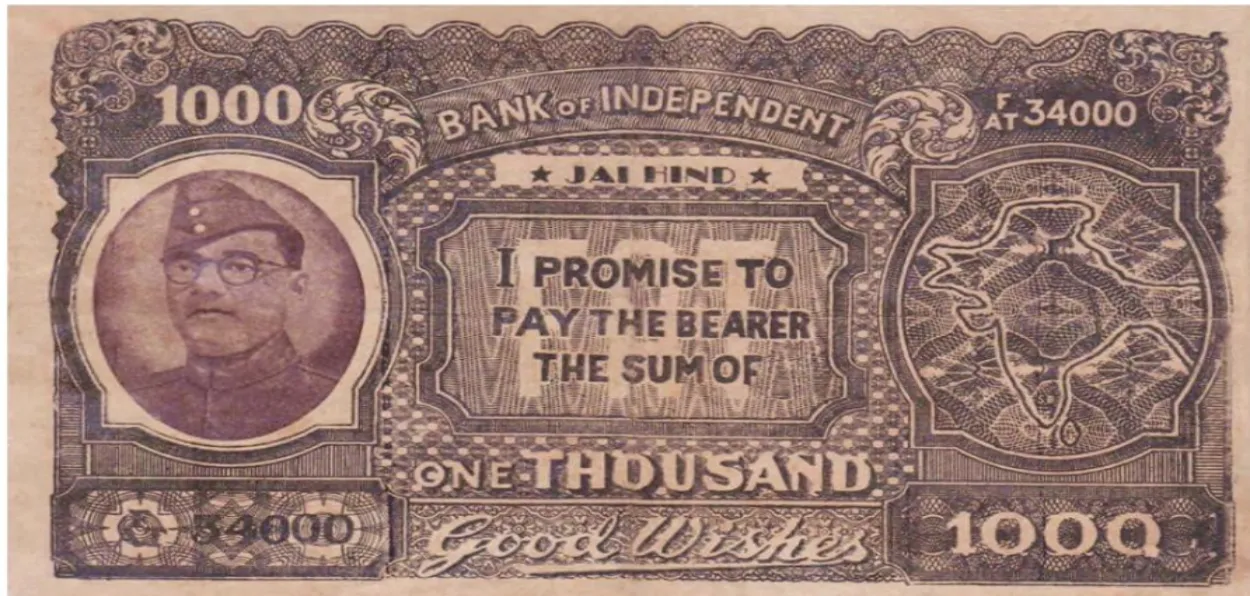
Saquib Salim
Many believed that the Azad Hind Fauj or the Indian National Army led by Subhas Chandra Bose during the Second World War was made of Indian Prisoners of War captured by Japan. This is a misconception, far away from reality.
A Slice Of History
The reality is that INA was a military unit of Arzi Hukumat-i-Azad Hind (The Provisional Government of Free India). Popularly known as Azad Hind Sarkar, this government led by Subhas Chandra Bose had all the working departments of a civilian administration as health, women empowerment, research, civil services, and banks. It also has its currency. The provisional government was recognised by several countries.
Initially, the government was being run on crowdfunding from the Indian Diaspora of Malaysia, Singapore, Burma, and other Southeast Asian countries. Soon, Bose felt the need to have a central banking system and currency.
An official notification from the Azad Hind Sarkar declared, “His Excellency Netaji Subhas Chandra Bose inaugurated the National Bank of Azad Hind Ltd., on Wednesday, the 5th April, 1944. His Excellency the Finance Minister of Burma, His Excellency the Ambassador of Nippon, and other distinguished members of the Burmese Government and high ranking Officers of the Imperial Nipponese Army were also present.
“The aims and objectives of the National Bank of Azad Hind Ltd., are primarily two-fold Firstly this Bank will help to mobilise the financial resources of Indians as a part of our programme of Total Mobilisation, and secondly this Bank will serve the interests of Burma where it is now established.
“The Bank will also render service to the Provisional Government of Azad Hind by acting as its Agents.”
In April 1944, Bose was discussing plans to establish a central bank of Azad Hind Sarkar. Everyone was worried about the money. A woman officer of the INA in her book Jai Hind: Diary of a Rebel Daughter noted, “Netaji was discussing finance problems with a Muslim multi-millionaire here in Rangoon. He suggested to him that we must have our own Bank because a Government without a bank is unheard of. Again as soon as Imphal falls, our Government would be issuing its currency, and a bank would be invaluable then. Netaji asked our friend, the multi-millionaire, for his suggestions for it.
“The reply came in the form of a question "Netaji, with how much capital do you wish to make a beginning?” Subhas Babu suggested that fifty lakhs would suffice for the purpose. Prompt was the answer 'Oh-ho, is that all you want? Then, I myself shall give 30 lakhs, and the rest of the twenty lakhs I guarantee to present to you in a week. And within a fortnight our Bank had taken legal shape and opened its doors to business.”
The man in question was Abdul Ghani. He was an Indian businessman settled in Burma, who had donated his wealth to Bose and Azad Hind Sarkar.
Lt. M. G. Mulkar of the INA later recalled, "Ghani paid more than what he said. He gave a contribution of 63 lakhs of rupees in cash and goods for the maintenance of the Indian National Army. In addition to his princely donation, he also gave an estate called the Ziawari Estate, which is worth several crores of rupees."
S. A. Ayer was appointed Chairman of the bank while Dina Nath was one of the directors. When the war ended, the bank had 5,343,946 Dollars deposit. Apart from this, jewelry and gold worth 86,310 Dollars were also in the funds of Azad Hind Sarkar.
ALSO READ: When Syed Ahmad Barelvi asked a Maratha to join hands against British
The bank issued its currency notes which had Subhas Chandra Bose, Mahatma Gandhi, Jawaharlal Nehru, and Lakshmi Sehgal printed over them.
